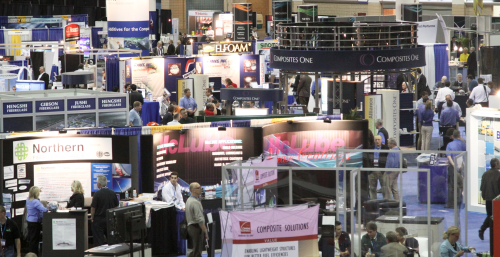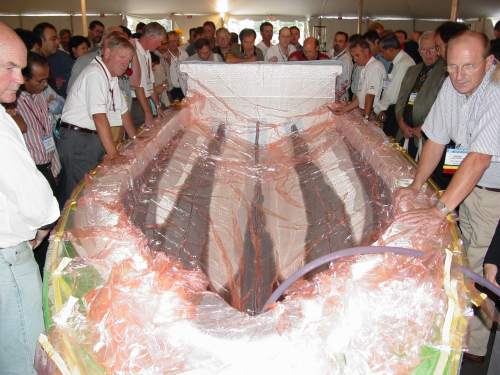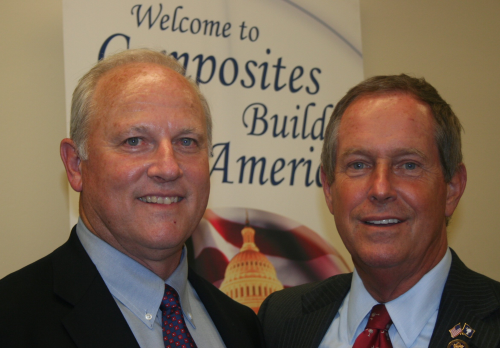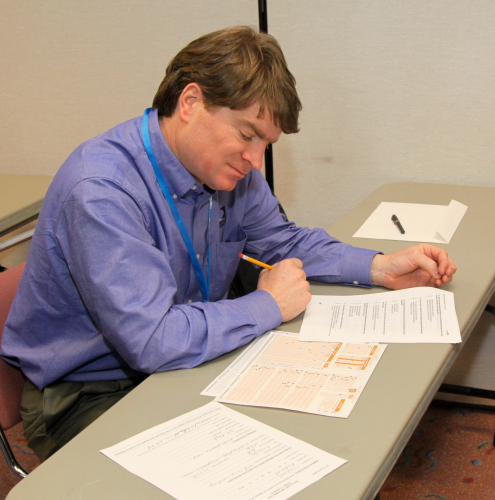




Despite the fact that the figures show a decline in US glass fibre thermoset composites shipments between 2005-2008, all those interviewed were very positive about the future.
Markets
Reinforced Plastics: Can the ACMA identify where it thinks growth will be achieved in specific market segments by application type?
Monty Felix, ACMA President: We predict that infrastructure and alternative energy (wind and solar power) markets will be growth markets for composites in the next few years. Also, we see growth in transportation and automotive sectors if the OEMs embrace the new CAFÉ (Corporate Average Fuel Economy) standards and the value composites can play in reducing weight in cars.
Emilio Oramas, ACMA Resin Statistics Chairman: I believe that we will also see growth in the aerospace market, especially when the Boeing 787 Dreamliner has its first flight and the wing-to-fuselage issue has been resolved. When we refer to infrastructure, we not only mean bridges but piping, oil/gas transmission and water/wastewater facility upgrades. Cured In place pipe (CIPP) rehabilitation is a specific growth market within infrastructure.
Reinforced Plastics:There is no doubt that around the world there has been a significant decline in the sales of pleasure boats due to the current/recent financial problems. When does the ACMA believe that we will start to see signs of recovery in this market segment?
Monty Felix: I feel that this market will start rebounding when credit and lending resources become available so that individuals can get loans. Also, as gasoline prices stabilise it will be more economical for boaters to operate on a regular basis without incurring an undue economic hardship. This is really a luxury consumer item and until consumers start spending, this could remain a stagnant market for the foreseeable future.
Barriers
Reinforced Plastics:In the US market, what does the ACMA believe are the barriers to the increased use of composites?
John Tickle, ACMA immediate Past President: We need design standards so that engineers know how to design with these materials for specific applications. In addition we need national codes and regulations that allow the safe use of composites in critical applications where safety is a key issue (e.g. buildings). We also need to maintain the ability of the composites industry to manufacture consistent and quality products. At the same time we need to ensure that experienced personnel are not lost by companies due to budget reductions and cutbacks because when the economy does turn around, we’ll need to be ready to build the same products again.
Composites Caucus
Reinforced Plastics:The ACMA has recently announced its Composites Caucus. Can you provide some details regarding how it is structured and what its aims are?
Monty Felix: The Congressional Composites Caucus is the first ever forum for Members of Congress to learn about the benefits of composites materials and the impact our industry has on the country. Our initial caucus event took place in July in Washington, D.C. The event, which focused on the use of composites to repair and re-build our nation’s crumbling infrastructure – such as bridges – was a notable success. To date, more than 20 Members of Congress have joined the caucus because they are interested in working together to support the interests of our industry when they see there is a benefit to their legislative efforts.
Initiatives
Reinforced Plastics:What other programmes does the ACMA run, or is planning to run, that will boost the use of composites in the US?
Monty Felix: The ACMA’s Composites Growth Initiative is a very active participant on codes and standards committees in an effort to encourage specifiers to design and engineer using composites. We are working with the ACMA’s Pultrusion Industry Council and the American Society of Civil Engineers to produce a preliminary standard for a final ’Load and Resistance Factor Design Standard for Pultruded FRP Composites.‘ This standard will be a tool for structural engineers, providing information and confidence in designing with composites structures such as building frames, cooling towers, and other constructed facilities that typically use steel or aluminum structural profiles.
The ACMA also works with the American Concrete Institute to produce standards and specifications for FRP composites used to design new or repair existing concrete and masonry structures. In addition the ACMA is actively involved in providing codes that enable better use of composite utility poles and other electrical structures. The ACMA’s efforts to change the building codes to make composites more easy to specify continues with the International Code Council’s newest International Building Code. There is no doubt that understanding fire performance of composites in building applications will be key to our success.
Training
Reinforced Plastics: Does the ACMA have view as to what areas require/need improvement by the US composites industry?
Monty Felix: With continued globalisation, US fabricators will need to become more efficient. This means embracing all the methods available to reduce cost while producing high-quality products. Cost reduction starts with training employees before they get onto the shop floor, and continuing their training throughout their employment. Better production methods – lean manufacturing and six sigma programs to name two – need to be implemented. ACMA’s current CCT programmes offer the initial training necessary to develop qualified workers. Partnerships with local community colleges and technical schools must also be established.
Reinforced Plastics:Could you provide an overview of the CCT programme?
John Tickle: The Certified Composites Technician (CCT) programme was created by the ACMA in 1999 to respond to the composites industry's need for uniform training and technical skills. CCT training focuses on the fundamental process technology used in producing a wide range of products.
These programme-specific certifications place particularly emphasis on the knowledge and technical skills required in production. The CCT programme is designed to elevate standards in the industry, enhance individual performance, and recognise those who demonstrate a prescribed level of knowledge in a specific specialisation.
Certified Composite Technicians are acknowledged as valued individuals within a manufacturing arena that is becoming progressively competitive and technical. Employers are increasingly acknowledging the benefits of employees with a higher level of knowledge that produce better products with improved efficiency. I am one of them – I have my CCT.
Reinforced Plastics:Is CTT a US only qualification or are non-US residents also applying for certification?
John Tickle: CCT is available to US and non-US residents, and we have CCTs in many countries. We are even willing to license CCT to associations in other countries so their members can have broader access to state-of-the-art training.
Reinforced Plastics:How many people have CCT registration and what future aims does the ACMA have for the programme?
John Tickle: Today, there are nearly 4000 certified composites technicians and the number continues to grow each year. We will be offering CCT tutorials in open moulding, corrosion and vacuum infusion processing (VIP) at our upcoming COMPOSITES 2010 event, February 9-11, in Las Vegas. We also will be holding certification exams during the three-day event.
|
The American Composites Manufacturers Association (ACMA) is the world’s largest trade association serving the composites industry. It was formed 30 years ago to provide education and support to composite manufacturers. Today, its more than 850 members include open and closed moulders, suppliers, distributors, consultants, academics, and many others with an interest in the composites market. |
As for growing the programme, ACMA constantly is evaluating the specific educational curriculum needs of the industry, and has partnered with various academic institutions to bring programmes to the industry. We most recently partnered with the Southern Maine Community College in Brunswick, Maine, to develop a one- and two-year composites curriculums as well as a CCT-VIP [vacuum infusion processing] programme.
Open or closed moulding
Reinforced Plastics:In Europe there has been significant movement away from open to closed moulding, primarily for legislative reasons. Is there a similar situation in the US?
Monty Felix: ‘Legislative reasons‘ are not the same as ’health reasons.’ The materials we use have low toxicity. When readily available safe processing methods are used, the risk of health effects is very low. Our workers, plant neighbours and customers are safe.
Closed moulding is good for some products – improving performance and consistency of the parts. But it's also less flexible than open moulding, and many markets do not need the higher product performance and will not pay for closed moulding.
Reinforced Plastics:Does the ACMA consider that open moulding will continue to be used in the US for the production of significant percentage of composite components in the future?
Monty Felix: Open moulding is a great process for smaller companies like mine because it has low cost and is very flexible. When properly managed it is very safe. So, I’d say that open moulding will remain an option in the US for a number of composites components such as large, complex parts, or parts produced in lower volumes that are not easily or economically converted to closed moulding processes.
Reinforced Plastics: How does the ACMA believe that companies involved in open moulding (either as materials suppliers or component producers) will meet the obvious environmental challenges?
Monty Felix: I’m not aware of any environmental challenges. The chemicals we use are of low toxicity and our industry uses safe processing methods. We are regulated at national and state levels by the EPA [Environmental Protection Agency] and the OSHA [Occupational Safety and Health Administration]. The ACMA is committed to helping our members stay in full compliance with the applicable regulations.
Reinforced Plastics: In Europe there is legislation to force companies to look into recycling. What is the situation in the US?
Monty Felix: Firstly, composite products last a long time, so currently not much waste is produced. Furthermore, composites never degrade nor decompose in the environment, so it is very safe to dispose of them via landfill. Also composites are not used to make disposable consumer items, so they do not cause litter or marine debris problems.
Composites have lower energy input than metals or concrete, and they are already more green, even though at this point they are not recycled.
If we are forced to recycle composite materials, it would increase costs to our customers without providing any environmental benefit.






